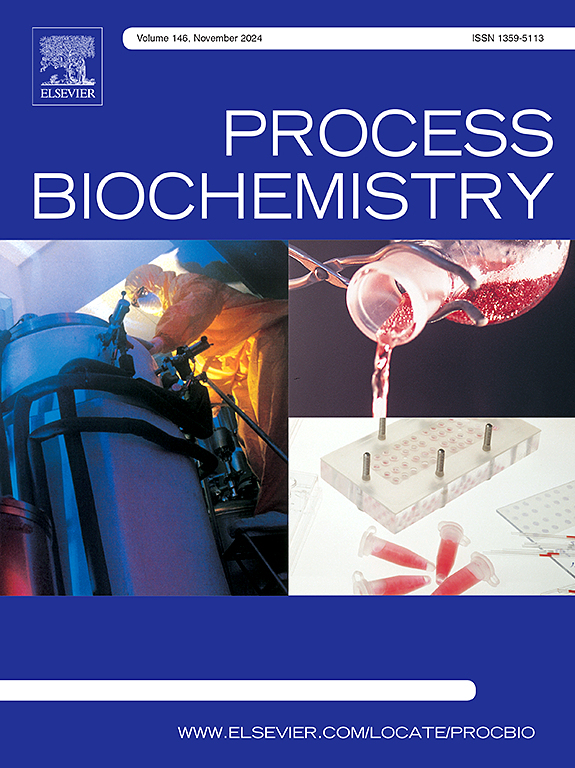偶氮染料生物脱色过程中粉末活性炭的电化学特性与细菌内部生化过程之间的相互作用:一种解释机制
IF 3.7
3区 生物学
Q2 BIOCHEMISTRY & MOLECULAR BIOLOGY
引用次数: 0
摘要
先前的报告强调了粉末活性碳(PAC)的氧化还原介质特性,本研究旨在评估这些特性,以提高准肺炎克雷伯氏菌 GT7 对偶氮染料的脱色能力。研究发现,在培养基中加入 0.5 % 的 PAC 可提高培养初期的生物脱色率。化学分析显示,在有 PAC 和没有 PAC 的微生物系统中,染料都会转化为芳香胺。然而,当初始染料浓度(Cid)为 2 mM 或更高时,一些染料会残留在 PAC 表面和培养基中。相比之下,不含 PAC 的系统在所有初始染料浓度下都几乎实现了 100% 的生物脱色。在初始染料浓度较高的微生物体系中,PAC 对脱色效率的负面影响不能完全由其氧化还原介质功能来解释。本研究利用 PAC 的双电层(EDL)两性-多南模型和 Mitchell 的细菌质子动力(PMF)化学渗透模型对此进行了探讨。研究发现,PAC 双电层中的电荷储存调节着电子传递通量,质子种类增强了细菌膜上的质子动力。这些观察结果加深了人们对 PAC 在微生物脱色过程中的作用及其未来潜在应用的理解。本文章由计算机程序翻译,如有差异,请以英文原文为准。
Interaction between the electrochemical properties of powdered activated carbon and the biochemical processes within bacteria in Azo dye biodecolorization: An explanatory mechanism
Drawing on prior reports highlighting the redox mediator properties of powdered activated carbon (PAC), this study was designed to evaluate these properties to enhance the decolorization of azo dye by Klebsiella quasipneumoniae GT7. It was found that the presence of 0.5 % PAC in the medium increased the biodecolorization rate early in incubation. Chemical analysis revealed that dye conversion into aromatic amines occurred in microbial systems both with and without PAC. However, at initial dye concentrations () of 2 mM or higher, some dye remained on the PAC surface and in the medium. In contrast, the PAC-free system achieved nearly 100 % biodecolorization at all initial dye concentrations. The negative impact of PAC on decolorization efficiency in microbial systems with high initial dye concentrations cannot be solely explained by its redox mediator function. This study used the amphoteric-Donnan model for PAC's electrical double layer (EDL) and Mitchell's chemiosmotic model for bacterial proton motive force (PMF) to explore this. It found that charge storage in PAC's EDL regulates electron transfer fluxes, and proton species enhance the proton motive force across the bacterial membrane. These observations improve the understanding of PAC's role in microbial decolorization and its potential future applications.
求助全文
通过发布文献求助,成功后即可免费获取论文全文。
去求助
来源期刊

Process Biochemistry
生物-工程:化工
CiteScore
8.30
自引率
4.50%
发文量
374
审稿时长
53 days
期刊介绍:
Process Biochemistry is an application-orientated research journal devoted to reporting advances with originality and novelty, in the science and technology of the processes involving bioactive molecules and living organisms. These processes concern the production of useful metabolites or materials, or the removal of toxic compounds using tools and methods of current biology and engineering. Its main areas of interest include novel bioprocesses and enabling technologies (such as nanobiotechnology, tissue engineering, directed evolution, metabolic engineering, systems biology, and synthetic biology) applicable in food (nutraceutical), healthcare (medical, pharmaceutical, cosmetic), energy (biofuels), environmental, and biorefinery industries and their underlying biological and engineering principles.
 求助内容:
求助内容: 应助结果提醒方式:
应助结果提醒方式:


